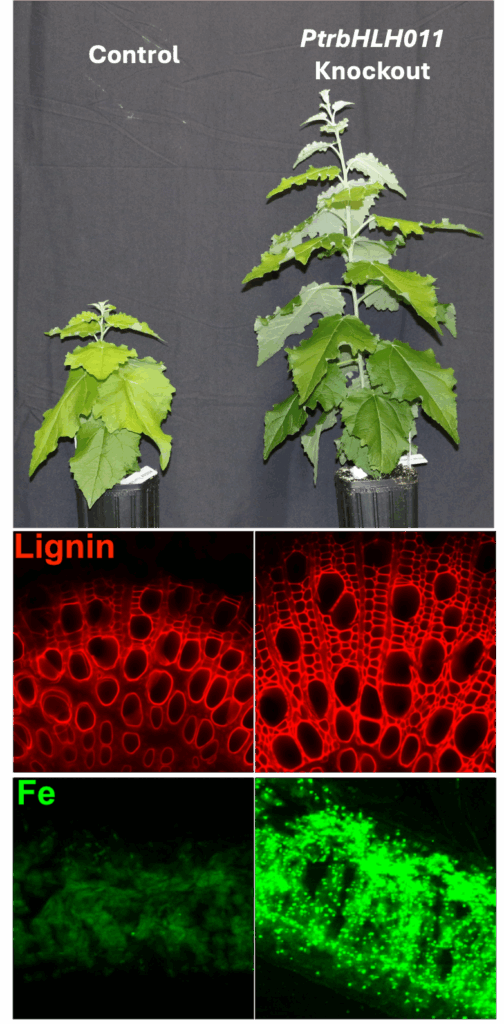Adapted from this Brookhaven National Laboratory press release

Cell walls don’t just provide support and protection for plants — they’re also packed with energy-rich biomaterials that could open new pathways for additional fuel, chemical, and material sources in the U.S. That’s why a team of Foundry users, working with staff, are untangling the complex genetic mechanisms that regulate these useful plant materials, known as biomass.
In a study recently published in The Plant Biotechnology Journal, the research team identified a plant protein that plays a key role in three important biological processes in poplar plants — iron deficiency responses, cell wall biosynthesis, and the synthesis of disease-fighting molecules.
“The protein is called PtrbHLH011, and it first caught our attention several years ago when we were identifying genes and proteins that influence how poplar plants respond to nutrition stresses,” said Meng Xie, a biologist at Brookhaven National Laboratory and the lead author on the new paper. “We found that expression of the PtrbHLH011 gene was largely reduced in stressed plants growing in an iron-deficient medium.”
During photosynthesis, plants need iron to convert sunlight into chemical energy that powers growth. With a deeper understanding of how plant genes and proteins like PtrbHLH011 work, biologists are working to develop bioenergy crops that can hyperaccumulate this important mineral and thrive even on iron-deficient, marginal land.
Traditionally, researchers have worked to increase cell wall sugars that can be converted into biofuels. But in recent years, a rigid cell wall component called lignin has caught their attention because it can be used to produce valuable bioproducts with industrial applications, like cement and adhesives.
In this case, collaborators at the University of Maryland developed poplar plants lacking PtrbHLH011. The knockout plants simultaneously produced twice as much lignin and exhibited enhanced growth for the first time ever. This was especially surprising because prior studies show that increasing lignin content — and consequently, stiffening cell walls — typically diverts energy from growth and limits the overall biomass yield.
The modified plants also accumulated three times more iron in their leaves and increased production of flavonoids, which are compounds that can help plants fight disease.
The modified plants also accumulated three times more iron in their leaves and increased production of flavonoids, which are compounds that can help plants fight disease.
Consistent with these observations, plants engineered to overexpress the PtrbHLH011 gene exhibited the opposite traits: stunted growth, weaker cell walls, increased sensitivity to disease, and yellow leaves characteristic of nutrient stress.
However, the researchers were surprised to find that knocking out the PtrbHLH011 protein increased several processes that require significant amounts of energy, which would normally impose a significant metabolic burden for the plants.
The surge in flavonoid synthesis is especially compelling as biologists ramp up bio-preparedness efforts to protect U.S. bioenergy plants from disease. Through future studies examining how plants respond to infection and disease, researchers aim to uncover underlying mechanisms that could be leveraged to strengthen crops’ resistance to pathogens that reduce biomass yield.
With the identification of a gene regulatory mechanism that is modulated by PtrbHLH011, the researchers are also working to fine tune the expression of its specific target genes. Collaborators at the Joint Genome Institute measured the levels of gene expression in the engineered plants, and Crysten Blaby at the Molecular Foundry provided insights into how the newly discovered regulatory mechanism adapted as land plants, like poplar, evolved.

